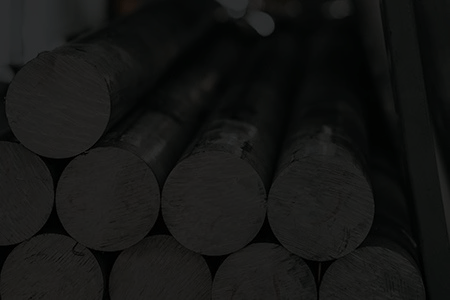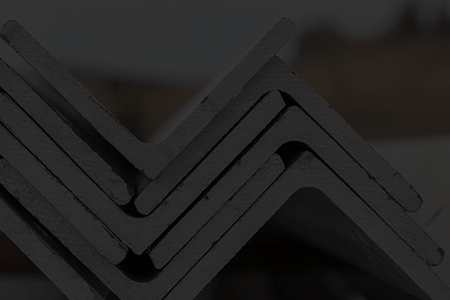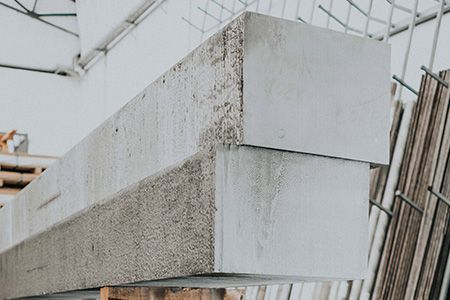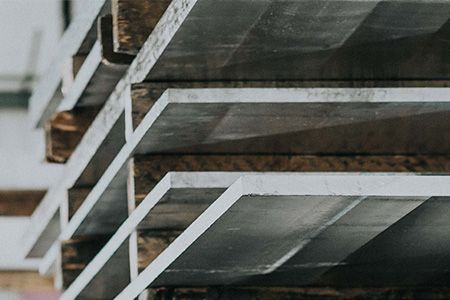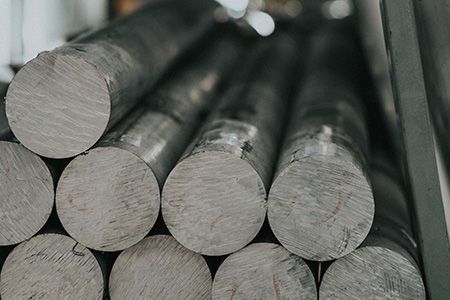Aluminum is the most abundant metallic element in Earth’s crust. Its lightness, electrical conductivity, corrosion resistance, and low melting point provide it with a wide range of applications. Some of its characteristics are:
- High malleability;
- Antimagnetic properties;
- High electrical and thermal conductivity;
- High corrosion resistance;
- Infinitely recyclable.
The density of aluminum is about one-third that of steel or copper. It is very malleable and an excellent choice for machining and casting.
Table of type
and shapes
There are several shapes, dimensions and alloys that Coppermetal can provide for your company. Check out the table below prepared by us to make your choice easier.
| Alloys | Shapes | Characteristics | Applications |
| 1050 | Sheets | High corrosion resistance. Good formability and weldability. | Reflectors, fixtures, household items, structural vessels and vats for the chemical and food industries, heat exchangers. |
| Coils | Low mechanical resistance. | ||
| Pipes | Suitable for decorative anodizing. | ||
| 1100 |
Sheets
|
High corrosion resistance. Good formability and weldability.
Low mechanical resistance. Suitable for decorative anodizing. Painéis decorativos, etiquetas metálicas, Decorative panels, metallic labels, | Decorative panels, metallic labels, household items, reflectors, fins. |
| 1200 | Coils | ||
| 1350 | Rods | Suitable for decorative anodizing. | Electrical Conductors. |
| Flat Bars | High weldability and corrosion resistance. | ||
| Pipes | High electrical conductivity. Good formability. | ||
| 2011 | Rods | High mechanical resistance. Good machinability. | Parts machined on automatic lathe. |
| Medium corrosion resistance. Not recommended for welding. | |||
| 3003 | Pipes | Medium mechanical resistance. | Heat exchangers, thermal insulation, chemical industry, household items, bodies. |
| Sheets | High corrosion resistance. | ||
| Coils | Good formability. Good weldability. | ||
| 3104 | Sheets | Good corrosion resistance.Good formability. | Bus and truck bodies, household items, equipment for the chemical and food industry, beverage and food cans, covers, gutters. |
| Coils | Moderate mechanical resistance. | ||
| 3105 | Sheets | Good mechanical resistance. | Bus and truck bodies, anti-skid flooring. |
| Coils | High corrosion resistance. Good formability. Good weldability. | ||
| 5005 | Sheets | High mechanical and corrosion resistance. | Household items, equipment for the chemical and food industry, coverings, gutters, and ceilings. |
| Coils | High formability. High weldability. | ||
| 5052 | Sheets | High mechanical and corrosion resistance. High weldability. | Bus and truck bodies, signs, naval industry, shutters, eyelets, stamped parts with high mechanical stress, railway wagons, anti-skid flooring, coverings. |
| Coils | Good formability. | ||
| Blades | |||
| 5083 |
Sheets
| Material with excellent acceptance for anodizing and welding processes, free of internal stresses. | Thermoplastic molds – (injection, blowing, RIM, ABS, PVC, PE, PU, among others); Automobile molds; Footwear molds; Agricultural molds; Prototypes; Metal-mechanical; Arms Industry; Naval Industry; Textile Industry; Aeronautical Industry; Others. |
| 5754 |
Anti-skid sheet
| Excellent corrosion resistance, especially in industrial environments. Reasonable mechanical resistance and good anodizing properties. | Naval and automotive industry, fishing equipment, food industry, welded structures, architectural applications. |
| 6060 | Rods | High corrosion resistance. | Sections in general, irrigation pipes, furniture, lighting, and ornaments. |
| Flat Bars | Medium mechanical resistance. | ||
| Pipes | Good formability. | ||
| Sections | Suitable for decorative matte anodizing. | ||
| 6061 | Pipes | High mechanical and corrosion resistance. | Structures, shipbuilding, vehicles, furniture industry, rivets, wagons, pipelines. |
| Rods | Good formability and weldability. | ||
|
Sections
| |||
| 6063 | Rods | High corrosion resistance. | Sections in general, irrigation pipes, furniture, lighting, and ornaments. |
| Flat Bars | Medium mechanical resistance. | ||
| Pipes | Good formability. | ||
| Sections | Suitable for decorative matte anodizing. | ||
| 6082 |
Rods, bars, pipes, and sections | Medium to high resistance. Offers good weldability, brazability, some corrosion resistance, formability, and machinability. | Piping; railings; furniture; architectural extrusions; truck and trailer flooring; doors; windows; irrigation. Structural engineering, shipbuilding, vehicles and equipment, parts machined on automatic lathes, cold forging. – Elements subjected to high mechanical stresses – Engineering structures – Shipbuilding and vehicle construction – Household appliances – Electrical industry and precision parts |
| 6101 | Rods | High electrical conductivity. | Electrical conductors and busbars. |
| Bars | Good corrosion resistance. | ||
| Pipes | Medium mechanical resistance. | ||
| Sections | |||
| 6261 | Rods | Good mechanical resistance. | Vehicle bodies, structures and equipment. |
| Pipes | Good corrosion resistance. Good formability. | ||
| Sections | Medium machinability. | ||
| 6262 |
Rods
| Great machinability. High mechanical resistance. | Parts machined on automatic lathe. |
| High corrosion resistance. | |||
| Suitable for decorative anodizing. | |||
| 6351 | Rods | High mechanical resistance. | Structural engineering, shipbuilding, vehicles and equipment, parts machined on automatic lathes, cold forging. |
| Pipes | High corrosion resistance. | ||
| Sections | Good formability. Good machinability. | ||
| 8011 | Coils | High weldability. Good corrosion resistance. | Packaging for pharmaceutical, food, and flexible products in general, lids, disposable plates and trays, cooling fins, helical pipes. |
| (Sheets) | Good formability. Low mechanical resistance. | ||
| 7075 |
Sheets,
Round Bar | The highest value of mechanical resistance; Medium corrosion resistance; Good forgeability; Good machinability; Hardness 150 to 180HB; | Parts subject to the highest mechanical stress, military industry, aeronautical industry, machinery and equipment, plastic injection molds, tool development. |
| 7021 | Blocks | Extremely low internal stress. Good form stability. High resistance. Good homogeneity. | Thermoplastic molds – (injection, blowing, RIM, TPU, PP, PE, among others), automobile molds, footwear molds, agricultural moulds, prototype molds, metal-mechanical, arms industry, aeronautical industry. |
| 7028 |
Sheets,
Blocks | Corrosion resistance. Good machinability. Good polishing. | Parts that require a high degree of machining, base sheets or sheets for workbenches of all types, thermoplastic injection molds for prototypes, blowing molds, molds for cast resins, storage blocks and support resistant to high impacts and load, chassis for machinery, bottle (PET) sealing machines, automobile molds, footwear molds, agricultural molds, arms and aeronautical industries, among others. |
|
ABNT/ASTM
Alloy | Al |
Si
(%) |
Fe
(%) |
Cu
(%) |
Mn
(%) |
Mg
(%) |
Cr
(%) |
Zn
(%) |
Ti
(%) |
Others
Each (%) |
Others
Total (%) |
| 1050 | 99,50 | 0,25 | 0,40 | 0,05 | 0,05 | 0,05 | – | 0,05 | 0,03 | 0,03 | – |
| min. | |||||||||||
| 1100 | 99,00 | 0.95 (Si+Fe) | 0,05 | 0,05 | 0,10 | 0,05 | 0,15 | ||||
| min. | 0,20 | ||||||||||
| 1200 | 99,00 | 1.00 (Si+Fe) | 0,05 | 0,05 | 0,10 | 0,05 | 0,05 | 0,15 | |||
| min. | |||||||||||
| 1350 | 99.50 | 0,10 | 0,40 | 0,05 | 0,01 | 0,01 | 0,05 | 0,03 | 0,10 | ||
| min. | |||||||||||
| 2011 | remaining | 0,40 | 0,70 | 5,00 | 0,30 | 0,05 | 0,15 | ||||
| 6,00 | |||||||||||
| 3003 | remaining | 0,60 | 0,70 | 0,05 | 1,00 | 0,10 | 0,05 | 0,15 | |||
| 0,20 | 1,50 | ||||||||||
| 3104 | remaining | 0,60 | 0,80 | 0,05 | 0,80 | 0,80 | 0,25 | 0,10 | 0,05 | 0,15 | |
| 0.25 | 1.40 | 1.30 | |||||||||
| 3105 | remaining | 0,60 | 0,70 | 0,30 | 0,30 | 0,20 | 0,20 | 0,40 | 0,10 | 0,05 | 0,15 |
| 0,80 | 0,80 | ||||||||||
| 5052 | remaining | 0,25 | 0,40 | 0,10 | 0,10 | 2,20 | 0,15 | 0,10 | 0,05 | 0,15 | |
| 2,80 | 0,35 | ||||||||||
| 5083 | remaining | 0,40 | 0,40 | 0,10 | 1,00 | 4,90 | 0,25 | 0,25 | 0,15 | ||
| 5754 | remaining | 0,25 | 0,40 | 0,10 | 0,10 | 2,80 | 0,35 | 0,10 | |||
| 6060 | remaining | 0,30 | 0,10 | 0,10 | 0,10 | 0,35 | 0,05 | 0,15 | 0,10 | 0,05 | 0,15 |
| 0,60 | 0,30 | 0,60 | |||||||||
| 6061 | remaining | 0,40 | 0,70 | 0,15 | 0,15 | 0,80 | 0,04 | 0,25 | 0,15 | 0,05 | 0,15 |
| 0,80 | 0,40 | 1,20 | 0,35 | ||||||||
| 6063 | remaining | 0,20 | 0,35 | 0,10 | 0,10 | 0,45 | 0,10 | 0,10 | 0,10 | 0,05 | 0,15 |
| 0,60 | 0,90 | ||||||||||
| 6082 | remaining | 1,30 | 0,50 | 0,10 | 1,00 | 1,20 | 0,25 | 0,20 | 0,10 | ||
| 6101 | remaining | 0,30 | 0,50 | 0,10 | 0,03 | 0,35 | 0,03 | 0,10 | 0,03 | 0,10 | |
| 0,70 | 0,80 | ||||||||||
| 6262 | remaining | 0,40 | 0,70 | 0,15 | 0,15 | 0,80 | 0,04 | 0,25 | 0,15 | 0.05* | 0.15* |
| 0,80 | 0,40 | 1,20 | 0,14 | ||||||||
| 6351 | remaining | 0,70 | 0,50 | 0,10 | 0,40 | 0,40 | 0,20 | 0,20 | 0,05 | 0,15 | |
| 1,30 | 0,80 | 0,80 | |||||||||
| 7021 | remaining | 0,25 | 0,40 | 0,25 | 0,10 | 1,20 | 0,05 | 5,00 | 0,10 | 0,05 | 0,15 |
| 1,80 | 6,00 | ||||||||||
| 7028 | remaining | 0,35 | 0,50 | 0,10 | 0,15 | 1,50 | 0,20 | 4,50 | 0,05 | 0,05 | 0,15 |
| 0,30 | 0,60 | 2,30 | 5,20 | ||||||||
| 7075 | remaining | – | 0,35 |
1,20
1,60 | 0,20 |
2,10
2,50 |
0,18
0,23 |
5,10
5,60 | 0,30 | 0,05 | 0,15 |
| 0,30 | |||||||||||
| 8011 | remaining | 0,50 | 0,60 | 0,10 | 0,20 | 0,05 | 0,05 | 0,10 | 0,05 | 0,15 | |
| 0,90 | 1,00 |
* Bismuth (Bi) and Lead (Pb) ranging from 0.4% to 0.7% each, not included in other elements.
Notes:
1. The mentioned values represent maximum limits per chemical element, except when minimum and maximum ranges are indicated.
2. Chemical Composition equivalent to the ASTM B-221 standard (ABNT-NBR 6834).
3. The indicated values do not imply a formal guarantee.
| ABNT/ASTM Alloy | DIN | Temper | Tensile Strength Mpa (N/mm²) Min. | Tensile Strength Mpa (N/mm²) Min. | Yield Strength Mpa (N/mm²) Min. | Minimum Elongation “50mm” (%) | Brinell Hardness (HB) |
| 1050 | Al 99.5 | O | 55 | 95 | 15 | 22 | 20 |
| H14 | 95 | 130 | 70 | 3 | 26 | ||
| 1100 | – | O | 75 | 105 | 25 | 22 | 23 |
| H14 | 110 | 145 | 95 | 3 | 32 | ||
| 1200 | Al 99.0 | O | 75 | 105 | 25 | 22 | 23 |
| H14 | 110 | 145 | 95 | 3 | 32 | ||
| 1350 | E-Al | O | 55 | 95 | – | 22 | 20 |
| H14 | 95 | 130 | – | 3 | 30 | ||
| 2011 | Al Cu Pb Bi | T4 | 275 | – | 125 | 16 | – |
| T8 | 370 | – | 275 | 10 | 100 | ||
| 3003 | Al Mn Cu | O | 95 | 130 | 35 | 22 | 28 |
| H14 | 140 | 180 | 115 | 3 | 40 | ||
| 3104 | Al Mn | O | 150 | 200 | 60 | 15 | 45 |
| H32 | 190 | 240 | 145 | 3 | 58 | ||
| H34 | 220 | 265 | 170 | 3 | 66 | ||
| 3105 | Al Mn0.5 Mg0.5 | O | 95 | 145 | 35 | 19 | 28 |
| H14 | 150 | 200 | 125 | 2 | 40 | ||
| 5005 | Al Mg1.0 | O | 105 | 145 | 35 | 19 | 28 |
|
H14
H19 |
145
157 |
185
– |
115
137 |
2
– |
41
– | ||
| 5052 | Al Mg2.5 | O | 170 | 215 | 65 | 17 | 47 |
| H34 | 235 | 285 | 180 | 4 | 68 | ||
| 5083 | DIN (AlMg4.5Mn) – UNI (P-AlMg4.5) – BS (N8) |
H111
O F |
285
275 280 |
—
350 360 |
135
125 125 |
10
16 — |
70
60 68 |
| 5754 | AlMg3 | H111 | 190 | 260 | 80 | 10 | 55 |
| 6060 | Al Mg Si0.5 | T5 | 145 | – | 105 | 8 | 60 |
| 6061 | Al Mg Si Cu | T4 | 180 | – | 110 | 16 | 65 |
| T6 | 260 | – | 240 | 8 | 95 | ||
| 6063 | Al Mg Si0.5 | T5 | 145 | – | 105 | 8 | 60 |
| 6082 | — | T-6 | 300 | — | 255 | — | 90-110 |
| 6101 | E-Al Mg Si0.5 | T6 | 200 | – | 172 | 8 | 78 |
| 6261 | – | T6 | 265 | – | 225 | 10 | 90 |
| 6262 | – | T6 | 260 | – | 240 | 10 | 90 |
| 6351 | Al Mg Si1.0 | T6 | 290 | – | 255 | 10 | 95 |
| 7021 | Al Zn5.5 | T6 | 350 | 380 | 310 | 2,5 | 110 |
| Mg1.5 | |||||||
| 7028 | AI Zn5.5 | 300 | 320 | 240 | 3 | 100 | |
| Mg1.5 | |||||||
| 7075 |
Al Zn5.6 Mg2.5 Cu1.6 Fe0.35 Cr0.23 Mn0.20 Si0.30 Ti0.30 | T651 | 480 | 540 | 390 | 4 | 150 |
| 8011 | Al Fe Si | O | 80 | 120 | 50 | 12 | 28 |
| H14/H24 | 120 | 210 | 110 | 4 | 35 |
Notes:
1. The indicated values do not imply a formal guarantee.
2. Stress data are expressed in megapascal units (Mpa), equivalent to 1N/mm2. To obtain the unit measurement in kgf/mm2, the indicated value is divided by 9.807. Classification of Tempers:
O – Annealed: Applies to finished products in the state in which they have the lowest mechanical resistance value.
H – Hardened: Applies to products made of non-heat-treatable alloys, that is, alloys where the increase in mechanical resistance is achieved only by cold plastic deformation (hardening).
F – As Manufactured: Applies to products obtained through forming processes in which no special control is used over the thermal or work hardening conditions. Limits are not specified for the mechanical properties.
T – Heat Treated: Applies to products that undergo heat treatment with or without complementary plastic deformation, which produces stable physical properties different from those obtained with “F”, “O”, and “H”.
3. For alloys with an H114 temper, use the limits specified in the “O” temper.
4. For alloys with an H154 temper, use the limits specified in the “H14” temper.
5. For rolled materials, the elongation values correspond to thicknesses from 0.63 to 1.20m.
6. Mechanical Properties according to the ABNT-NBR 7823 (rolled) and ABNT-NBR 7000:2005 (extruded) standards.
| Alloy | Density at 20 °C (p=Specific Weight) (g/cm³) | Melting Temperature (°C) | Specific Heat 0 to 100 °C (cal/g °C) | Coefficient of Thermal Expansion at 20° to 100°C (10-6°C) | Thermal Conductivity at 25 °C (cal/cm/cm²/sec °C) | Electrical Conductivity at 20 °C (% IACS) | Modulus of Elasticity (MPA) | Modulus of Rigidity (MPA) |
| 7075 | 2,75 | 475 – 630 | 0,22 | 23 | 0,35 | 40 | 73.000 | 27.500 |
| 7021 | 2,80 | 510 – 630 | 0,21 | 23 | 0,33 | 37 | 70.000 | 26.500 |
| 7028 | 2,77 | 510 – 630 | 0,21 | 23 | 0,33 | 37 | 70.000 | 26.500 |
Notes:
2. The indicated values do not imply a formal guarantee.
Related
Products
Check out our wide range of products and find out at Coppermetal the best solution for your company.
